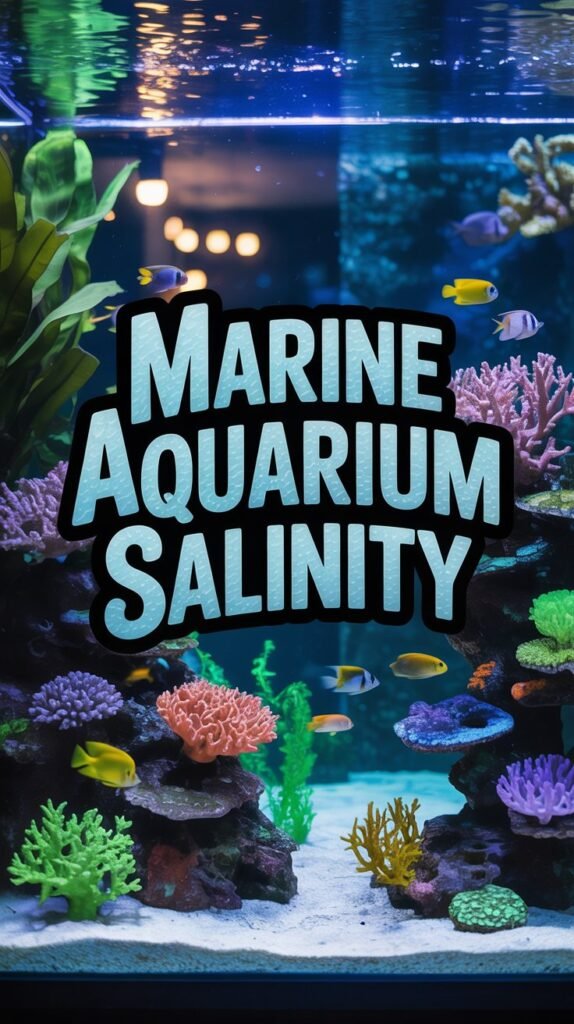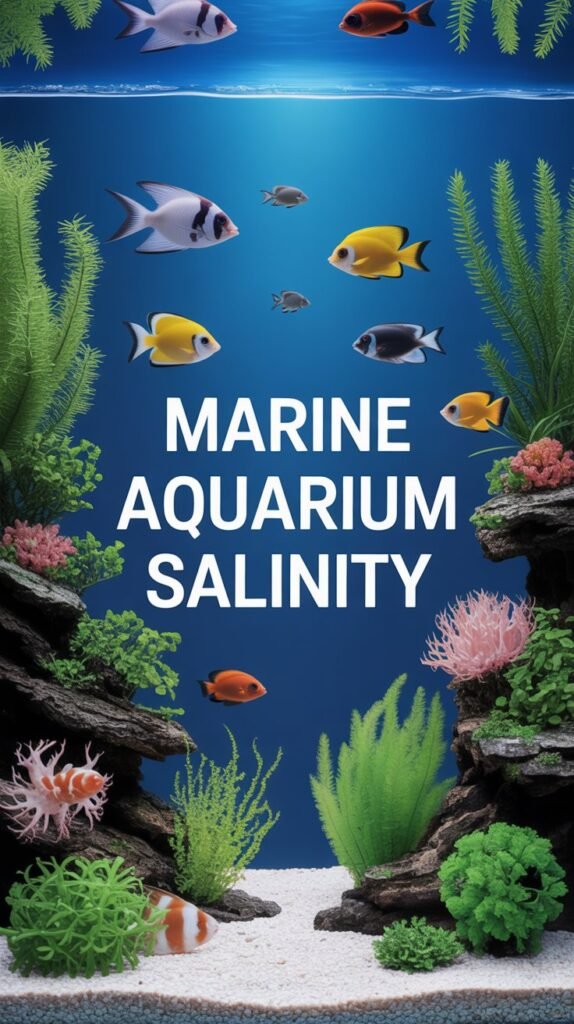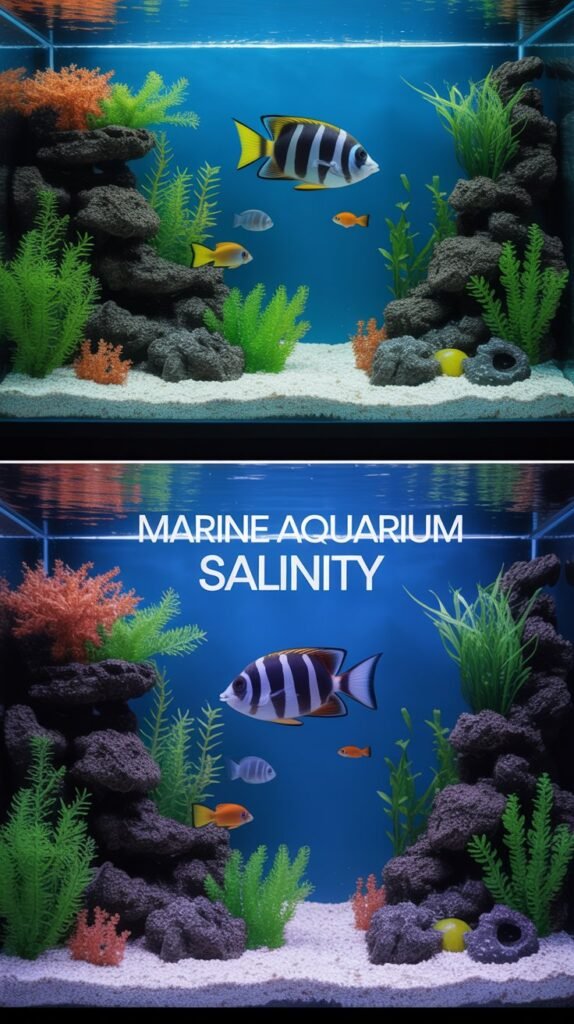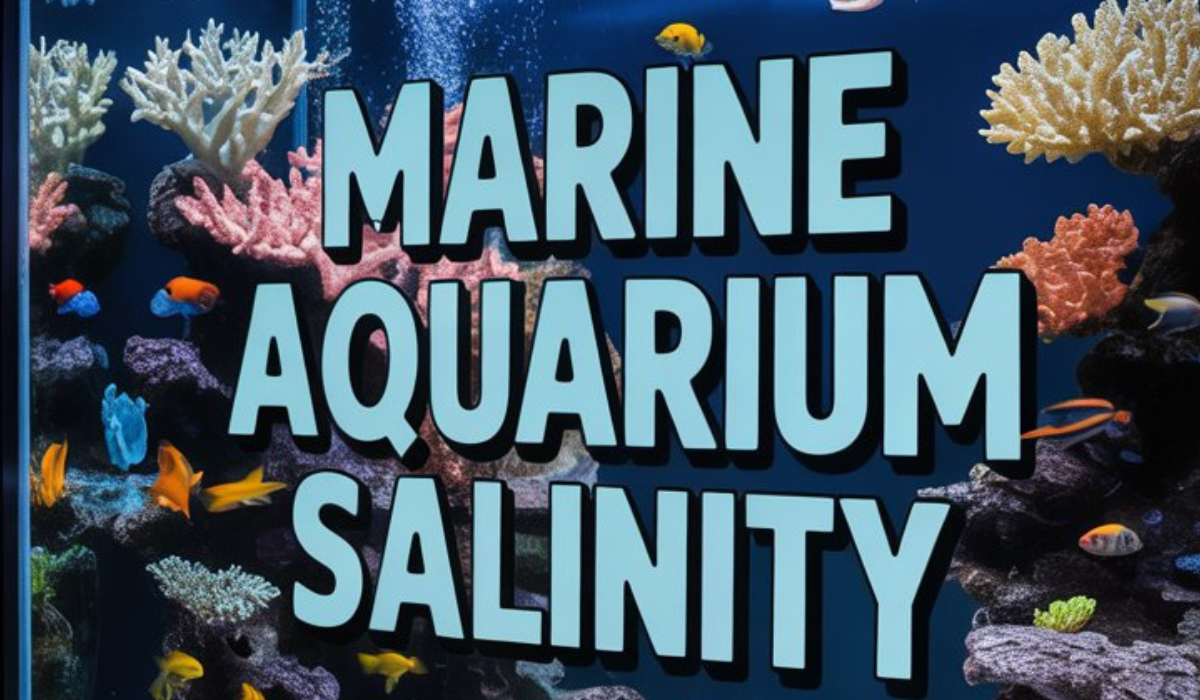Maintaining a healthy marine aquarium is all about balance — and one of the most crucial parameters to monitor is salinity. For saltwater fish, corals, and invertebrates, salinity plays a vital role in their overall health, biological function, and survival.
If your salinity levels are off — either too high or too low — it can lead to stress, disease, and even death among marine species. So, understanding how to measure, adjust, and maintain marine aquarium salinity is essential for every saltwater aquarist.
This detailed guide covers everything you need to know about marine aquarium salinity: what it is, why it matters, how to measure it, how to maintain stability, and the best tools for accurate readings.
What Is Salinity in a Marine Aquarium?
Salinity refers to the amount of dissolved salts (mainly sodium chloride) in the water. In marine aquariums, it determines how closely your tank mimics the natural ocean environment.
It’s usually measured in:
- Specific Gravity (SG): A ratio comparing the density of saltwater to pure water.
- Parts per Thousand (ppt): The number of salt grams per liter of water.
Typical Ocean Salinity
- Natural Seawater: ~35 ppt
- Specific Gravity: 1.025 to 1.026
This range is considered ideal for most marine aquariums, as it supports fish, corals, and invertebrates just like their native ocean habitats.
Why Salinity Matters in a Marine Aquarium

Salinity isn’t just a number — it affects nearly every biological process inside your aquarium. Both fish and corals have evolved to live in stable salinity levels. Even slight fluctuations can cause significant stress.
Here’s why maintaining consistent salinity is so important:
1. Osmoregulation in Fish
Marine fish constantly regulate internal salt levels to balance their body fluids with their environment. If salinity changes too quickly, it disrupts osmoregulation, causing dehydration or overhydration, which can be fatal.
2. Coral Health
Corals rely on stable salinity for photosynthesis (via zooxanthellae algae) and calcium carbonate formation. Incorrect salinity can lead to bleaching, tissue loss, or stunted growth.
3. Invertebrate Sensitivity
Shrimp, snails, crabs, and starfish are especially sensitive to changes in salinity. Sudden fluctuations can cause molting issues, osmotic shock, or death.
4. Biological Filtration
Beneficial bacteria that break down waste are adapted to specific salinity levels. A sudden drop or rise can harm your biofilter and destabilize your nitrogen cycle.
5. pH and Alkalinity Stability
Salinity influences the buffering capacity of water. Low salinity can reduce alkalinity, leading to dangerous pH swings.
Ideal Marine Aquarium Salinity Levels
While 35 ppt (1.025 SG) is a general standard, the ideal salinity range depends on your aquarium type:
| Tank Type | Ideal Salinity (ppt) | Specific Gravity (SG) |
|---|---|---|
| Fish-Only (FO) | 30–33 ppt | 1.020–1.024 |
| Fish + Live Rock (FOWLR) | 33–35 ppt | 1.023–1.025 |
| Reef Tank (Corals & Invertebrates) | 35 ppt | 1.025–1.026 |
| Brackish Water Tank | 5–20 ppt | 1.005–1.015 |
Tip: Consistency is more important than the exact number — avoid rapid or large swings.
How to Measure Salinity in a Marine Aquarium

Regular testing is key to maintaining a healthy saltwater environment. There are three primary tools used to measure salinity:
1. Hydrometer
A hydrometer measures specific gravity by floating a calibrated arm or needle in water. It’s simple and inexpensive but can be less accurate over time due to bubbles, dirt, or temperature variations.
Pros:
- Affordable
- Easy to use
Cons:
- Needs frequent calibration
- Less precise for reef tanks
Usage Tip: Rinse with freshwater after each use to prevent salt buildup.
2. Refractometer
A refractometer measures light refraction through water to determine salinity. It’s far more accurate than a hydrometer and widely used by advanced aquarists.
Pros:
- Highly accurate (±0.001 SG)
- Quick readings
- Compact and durable
Cons:
- Requires calibration with distilled water
- More expensive than hydrometers
Best For: Reef aquariums and serious hobbyists.
3. Digital Salinity Meter
Digital meters use electronic sensors to measure conductivity and convert it into salinity or specific gravity.
Pros:
- Most accurate option
- Displays ppt or SG instantly
- Can measure temperature simultaneously
Cons:
- Higher cost
- Requires battery and maintenance
Best For: Professional aquariums or those who prefer precise, hassle-free testing.
How to Mix Saltwater Properly
Creating the perfect marine environment starts with mixing saltwater correctly. Here’s how:
Step-by-Step Guide
- Use RO/DI Water
- Always use Reverse Osmosis (RO) or Deionized (DI) water to eliminate impurities, chlorine, and heavy metals.
- Tap water can introduce unwanted minerals and algae-promoting nutrients.
- Add Marine Salt Mix
- Use a high-quality marine salt mix formulated for aquariums.
- Add salt slowly while circulating water with a powerhead or pump.
- Check Salinity
- Test the mixture with a refractometer or hydrometer once the salt dissolves completely.
- Aim for 1.025 SG (35 ppt).
- Adjust if Necessary
- If salinity is too high → add RO/DI water.
- If salinity is too low → add more salt mix gradually.
- Match Temperature
- Ensure the new saltwater temperature matches your aquarium (typically 76–80°F or 24–27°C).
- Let it Aerate
- Allow the water to mix and aerate for 12–24 hours before adding it to your tank.
How to Adjust Salinity in Your Aquarium

Salinity can fluctuate due to evaporation, water changes, or incorrect mixing. Here’s how to correct it safely:
If Salinity Is Too High:
- Add fresh RO/DI water gradually to dilute salt concentration.
- Avoid rapid changes; lower salinity slowly (0.001 SG per day) to prevent stress.
If Salinity Is Too Low:
- Top off with pre-mixed saltwater instead of freshwater until it reaches the desired level.
- Again, make gradual adjustments to protect sensitive marine life.
Causes of Salinity Fluctuations
Salinity isn’t static — it changes naturally over time. Understanding the causes helps you maintain stability.
1. Evaporation
When water evaporates, only pure water leaves; salt remains, raising salinity.
Solution:
Top off with freshwater daily or install an Auto Top-Off System (ATO) to maintain consistent levels.
2. Overfilling or Water Changes
Adding too much freshwater or improper salt mixing during water changes can dilute salinity.
Solution:
Always mix replacement water to match the tank’s salinity before performing changes.
3. Equipment Leaks or Spills
Losing saltwater through leaks while topping off with freshwater reduces salinity.
Solution:
Fix leaks immediately and check salinity after repairs.
4. Salt Creep
Salt crystals can accumulate on tank edges and equipment, slowly reducing total salinity over time.
Solution:
Clean salt creep regularly and replace lost saltwater accordingly.
Effects of Incorrect Salinity
When salinity drifts out of the optimal range, marine organisms suffer. Here’s what can happen:
Low Salinity (Hyposalinity)
- Fish experience osmotic stress and dehydration.
- Corals may expel zooxanthellae, leading to bleaching.
- Invertebrates may lose control of bodily functions.
- Beneficial bacteria become inactive, causing ammonia spikes.
High Salinity (Hypersalinity)
- Fish become overhydrated, leading to lethargy and bloating.
- Corals can retract or lose tissue.
- Algae growth may accelerate due to imbalances.
Symptoms of Salinity Stress:
- Rapid gill movement or gasping
- Loss of appetite
- Faded coloration
- Unusual swimming patterns
- Coral retraction or bleaching
Early detection and correction are vital to prevent lasting damage.
Maintaining Stable Salinity
Consistency is the secret to a thriving marine tank. Here are the best practices:
1. Use an Auto Top-Off (ATO) System
An ATO replaces evaporated water automatically, preventing salinity spikes. It’s especially useful for reef tanks.
2. Test Weekly
Regularly check salinity using a refractometer or digital meter. Testing once or twice a week ensures early detection of changes.
3. Perform Regular Water Changes
Use properly mixed saltwater for water changes (typically 10–20% weekly). This keeps salinity, minerals, and trace elements balanced.
4. Keep Temperature Stable
Salinity readings vary with temperature — higher temperatures reduce density. Keep tank temperature between 76–80°F for accurate results.
5. Record and Monitor
Keep a logbook or app to record salinity readings, temperature, and adjustments. Trends help you identify issues early.
Marine Aquarium Salinity and Coral Health
Corals are particularly sensitive to salinity fluctuations. Even minor changes can cause bleaching, tissue loss, or polyp retraction.
Optimal Coral Salinity Range:
- Soft Corals: 33–35 ppt
- LPS (Large Polyp Stony) Corals: 34–35 ppt
- SPS (Small Polyp Stony) Corals: 35 ppt (most stable)
Tips for Coral Health:
- Maintain stable salinity within ±0.001 SG.
- Use RO/DI water for top-offs.
- Avoid overcorrections during water changes.
- Recalibrate refractometers monthly for accuracy.
Salinity and Marine Fish Species
Different fish species have different salinity preferences based on their native habitats.
| Fish Species | Preferred Salinity (ppt) | Notes |
|---|---|---|
| Clownfish | 33–35 | Hardy, tolerates minor variation |
| Tangs | 34–35 | Sensitive to fluctuations |
| Gobies | 30–35 | Adaptable to various levels |
| Wrasses | 33–35 | Require stable conditions |
| Puffers | 30–32 | Prefer slightly lower salinity |
| Seahorses | 30–33 | Sensitive to rapid changes |
Pro Tip: When introducing new fish, acclimate slowly using the drip method to match your tank’s salinity.
Brackish Aquariums vs. Marine Aquariums
It’s essential to distinguish between brackish and marine setups:
| Parameter | Brackish Tank | Marine Tank |
|---|---|---|
| Salinity | 5–20 ppt | 30–35 ppt |
| Specific Gravity | 1.005–1.015 | 1.023–1.026 |
| Typical Fish | Mollies, Archerfish | Clownfish, Tangs |
| Environment | River mouths, mangroves | Ocean reefs |
| Salt Mix | Brackish or marine | Marine reef mix |
A brackish tank bridges freshwater and marine environments, but true saltwater tanks require consistent oceanic salinity.
Common Mistakes to Avoid
- Using Tap Water
- Tap water contains impurities that affect salinity accuracy. Always use RO/DI water.
- Skipping Calibration
- Refractometers and digital meters must be calibrated regularly for accurate readings.
- Topping Off with Saltwater
- Only replace evaporated water with freshwater since salt doesn’t evaporate.
- Ignoring Temperature
- Salinity changes slightly with temperature — measure under consistent conditions.
- Sudden Adjustments
- Rapid salinity shifts can shock fish and corals. Always adjust gradually.
Long-Term Salinity Management
To maintain stable salinity over time:
- Invest in quality measuring instruments.
- Use an ATO system for consistency.
- Store pre-mixed saltwater for emergencies.
- Regularly clean salt creep and replace evaporated water.
- Keep a maintenance logbook to track stability trends.
Consistency, patience, and precision are key to marine aquarium success.
Conclusion
Salinity is one of the most critical factors in maintaining a thriving marine aquarium. It directly impacts fish health, coral growth, biological balance, and water chemistry.
By maintaining salinity between 1.025–1.026 specific gravity (35 ppt), using accurate measuring tools, and practicing consistent maintenance routines, you can create a stable, ocean-like environment where your marine life thrives.
Whether you’re caring for a fish-only setup or a delicate coral reef ecosystem, mastering marine aquarium salinity is the foundation of success. Remember — stability is everything in the saltwater world.
Frequently Asked Questions (FAQs) About Marine Aquarium Salinity
1. What is the ideal salinity for a marine aquarium?
The ideal salinity for most saltwater tanks is 35 ppt, equivalent to a specific gravity of 1.025–1.026.
2. How often should I check salinity in my tank?
Check salinity at least once or twice a week, and always before and after water changes or top-offs.
3. Can freshwater fish survive in saltwater if I slowly adjust salinity?
No. Freshwater fish lack the physiological adaptations to handle marine salinity, even with gradual acclimation.
4. What happens if salinity is too low?
Low salinity can cause osmotic stress, reduced immunity, and disrupted biological filtration. Corals may bleach or stop growing.
5. How do I raise salinity safely?
Add pre-mixed saltwater gradually over several hours or days until reaching the desired level. Avoid adding dry salt directly to the tank.
6. Can high salinity harm my fish?
Yes. High salinity can cause dehydration, stress, and kidney strain in fish. Adjust slowly if levels exceed 1.027 SG.
7. What’s the difference between ppt and specific gravity?
- ppt (parts per thousand): Measures salt concentration by weight.
- Specific Gravity: Compares saltwater density to pure water.
Both indicate salinity but use different scales.
8. How does evaporation affect salinity?
When water evaporates, salt remains behind, increasing salinity. Always top off evaporated water with freshwater only.
9. Can I use table salt for a marine tank?
No. Table salt lacks essential trace elements and may contain additives. Use a marine salt mix formulated for aquariums.
10. How do I acclimate new fish to my tank’s salinity?
Use the drip acclimation method for 30–60 minutes, slowly adjusting the salinity of the transport water to match your aquarium.
11. Do I need to maintain different salinity levels for corals and fish?
Generally, a uniform salinity of 35 ppt (1.025–1.026) works for both fish and corals. Stability is more important than variation.
12. Should I adjust salinity during water changes?
Yes. Always ensure new saltwater matches the tank’s salinity and temperature to prevent stress.
13. What tool gives the most accurate salinity reading?
A digital salinity meter or a refractometer provides the most accurate readings. Hydrometers are suitable for beginners but less precise.
14. Can I perform hyposalinity treatment for marine fish diseases?
Yes, hyposalinity (1.009–1.010 SG) can treat marine ich in fish-only quarantine tanks, but never use it in reef tanks with corals or invertebrates.
15. How do I keep salinity stable automatically?
Use an auto top-off (ATO) system that replaces evaporated water with freshwater in real time to maintain constant salinity levels.

